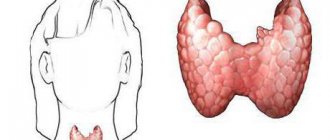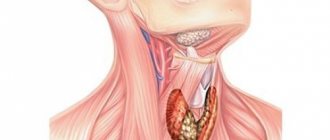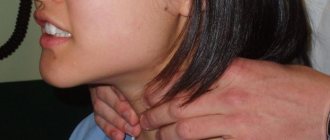What is hypothyroidism
Hypothyroidism is a clinical syndrome caused by decreased thyroid function. There are primary and secondary hypothyroidism. In primary hypothyroidism, a decrease in the production of thyroid hormones is associated with a pathological process in the gland itself, while the amount of thyroid-stimulating hormone (THG) synthesized by the pituitary gland even increases compared to the norm. Hypothyroidism is not a disease, but a specific condition of the body that is associated with a reaction to low levels of thyroid hormone concentrations. These symptoms usually disappear when the desired hormone levels are compensated. Hypothyroidism can also be associated with pathological processes that affect hormonal metabolism or depend on the functional deficiency of thyroid hormones.
Research on the role of thyroid hormones in brain metabolic processes
The important role of thyroid hormones in the metabolic processes of the adult brain was established by a team of scientists led by Marangel LB in 1997 (Marangell LB, George MS, Pazzaglia PJ, Callahan AM, Parekh P., Andreason PJ, Horwitz B., Herscovitch P ., Post RM “Inverse relationship of peripheral thyrotropin-stimulating hormone levels to brain activity in mood disorders”). Their study showed that an increase in the level of pituitary thyroid-stimulating hormone (TSH) in peripheral blood serum, which regulates the production of T3 and T4 hormones by the thyroid gland, entails a decrease in the level of glucose metabolism in the brain. It is known that glucose is practically the only source of energy for brain cells. When it breaks down into carbon dioxide and water, a large amount of energy is released. In a calm state of the body, the supreme commander consumes 60% of glucose and 20-25% of all oxygen entering the body.
With hypothyroidism, local cerebral circulation slows down by 23.4%, glucose metabolism - by 12.1%. This invariably entails a decrease in energy metabolism of the main organ of the central nervous system . This fact was proven in a study by another group of specialists led by Schwartz JM (Schwartz JM, Baxter LR, Mazziotta JC, Gerner RH, Phelps ME “The differential diagnosis of depression: relevance of positron emission tomography studies of cerebral glucose metabolism to the bipolar unipolar dichotomy").
In Russia, specialists from three reputable scientific institutions were studying the influence of the level of thyroid hormones in the blood on the energy exchange of the brain: Institute of Physics of the Russian Academy of Sciences , Russian State Medical University, Center of Neurology of the Russian Academy of Medical Sciences .
The joint research work of scientists (“Neuro-endocrine influences on energy metabolism and lateralization of the brain in thyroid pathology”) showed that a deficiency of thyroid hormones T3 and T4 leads to damage to brain tissue due to prolonged oxygen starvation, impaired glucose transport and amino acids and, ultimately, reduces the energy metabolism of a vital organ by 3 times . Normalizing thyroid status allows you to restore energy metabolism and improve cerebral circulation.
Classification of hypothyroidism
- Primary hypothyroidism Hypothyroidism caused by a decrease in the amount of functioning thyroid tissue (thyroid gland) postoperative hypothyroidism
- post-radiation hypothyroidism
- hypothyroidism caused by autoimmune damage to the thyroid gland (autoimmune thyroiditis, outcome of DTG into hypothyroidism)
- hypothyroidism caused by viral infection of the thyroid gland
- hypothyroidism due to thyroid tumors
- endemic goiter with hypothyroidism
- hypothyroidism of pituitary origin
- peripheral hypothyroidism generalized resistance to thyroid hormones
All forms of hypothyroidism are based on a decrease in the level of thyroid hormones, which causes metabolic shifts leading to disruption of the functioning of various organs and systems.
Classification of types of disease and their origins
In general, thyroid hypothyroidism can be considered from the point of view of its origin - acquired and congenital hypothyroidism are distinguished. However, the vast majority of cases of the disease are acquired. TSH in hypothyroidism can either increase or decrease. Among the origins of this type of hypothyroidism are:
- autoimmune thyroiditis in a chronic course (the human immune system damages the parenchyma of the gland);
- Iatrogenic hormone deficiency (develops after treatment with radioactive iodine or surgery to remove or partially cut off an organ).
Postoperative hypothyroidism rarely appears. Usually such deviations are irreversible. Hypothyroidism can also be provoked by the use of thyreostatics during the treatment of diffuse toxic goiter and a significant lack of iodine in the diet.
Congenital hypothyroidism can be observed in those who have pathological processes of a non-acquired nature in the thyroid gland. A similar picture is observed if hormonal synthesis is disrupted in the thyroid gland from birth - if, for example, hypothyroidism occurs during pregnancy. This often occurs when taking medications during pregnancy. The mother's hormones completely compensate for the lack of hormonal substances in the fetus. After birth, hypothyroidism manifests itself in children, which can lead to significant underdevelopment of the central nervous system.
Based on the location of the disorder, there are 3 types of disease:
- primary hypothyroidism (lies in the thyroid gland itself with an increase in thyroid-stimulating hormone);
- secondary hypothyroidism (associated with the work of the pituitary gland and a decrease in TSH);
- tertiary (impaired functioning of the hypothalamus).
The last 2 types are almost never found. The reasons for their development are damage to the pituitary gland and hypothalamus. Primary hypothyroidism has the following origins:
- inflammation;
- hypoplasia;
- improper synthesis of hormones at the hereditary level;
- insufficient iodine content in the body;
- thyroidectomy.
Note. In the initial stages, autoimmune hypothyroidism and subclinical hypothyroidism are noted.
Almost all cases of hypothyroidism are associated with a direct disruption of the structure and functioning of the organ that is responsible for the synthesis of thyroid hormones. This organ is the thyroid gland
Causes of hypothyroidism
Causes of primary hypothyroidism
Primary hypothyroidism can be caused by aplasia or hypoplasia of the thyroid gland. In young children, it is often detected in combination with cretinism (a sharp lag in physical and mental development) and deafness; hypothyroidism can be caused by surgical treatment of thyroid diseases, repeated administration of radionuclide iodine, long-term therapy with antithyroid drugs.
The development of hypothyroidism is explained not only by complications caused by therapeutic measures or their excessive volume, but also by the nature of the underlying pathological process (impaired biosynthesis of hormones as a result of a defect in enzymatic systems or iodine deficiency in areas where goiter is endemic; inflammatory diseases, often of an autoimmune nature, for example autoimmune Hashimoto's thyroiditis).
Most of the so-called spontaneous forms of primary hypothyroidism are of autoimmune origin. Rare forms of primary hypothyroidism include autoimmune primary hypothyroidism in combination with primary hypocortisolism, hypogonadism, sometimes hypoparathyroidism, and very rarely type I diabetes mellitus, as well as candidiasis. One of the variants of hypothyroidism is Hennes-Ross syndrome, in which a combination of symptoms of primary hypothyroidism and galactorrhea-amenorrhea syndrome is noted.
The disease develops after childbirth and is caused by an autoimmune lesion of the thyroid gland. Excess prolactin in Hennes-Ross syndrome is caused by primary hypothyroidism, pregnancy and childbirth. Secondary hypothyroidism is caused by a pathological process in the hypothalamic-pituitary system, the concentration of TSH in the blood is reduced. In secondary hypothyroidism, insufficiency of not only the thyroid-stimulating, but also other tropic functions of the pituitary gland is noted, i.e. Panhypopituitarism.
Causes of secondary hypothyroidism
The clinical picture of secondary hypothyroidism is combined with the clinical picture of hypocorticism, hypogonadism, etc. The pathogenesis of hypothyroidism is determined by a decrease in the biosynthesis and secretion into the blood of iodine-containing thyroid hormones thyroxine (T4) and triiodothyronine (T3) and inhibition of all types of metabolism. With hypothyroidism, oxygen consumption, heat production and heat exchange are reduced, the synthesis of protein and nucleic acids is disrupted, and protein breakdown products accumulate in the body.
The utilization of fat breakdown products and the absorption of glucose in the intestine slow down, metabolic processes in brain tissue are inhibited, and the biosynthesis of corticosteroid hormones and the exchange of sex hormones are reduced. In the skin, subcutaneous tissue, organs and tissues, mucinous substances accumulate - glycosaminoglycans, hyaluronic and chondroitinsulfuric acids, which, by retaining water, cause the development of a kind of mucous edema.
In severe hypothyroidism, mucinous fluid accumulates in the serous cavities - the pericardial cavity, pleural and abdominal cavities. In hypothyroidism, thyroid tissue exhibits aplasia, hypoplasia (sometimes hyperplasia), and atrophy (atrophy of gland tissue usually develops after chronic inflammatory processes, long-term use of iodine-containing and antithyroid drugs).
How to detect
In order to diagnose primary hypothyroidism in a timely manner, it is important to consult an endocrinologist at the slightest sign. He will conduct a full examination of the entire body and prescribe special diagnostic methods, including:
- blood test to determine the concentration of thyroid hormones in her serum; if their values are below 2.6 mmol/l for triiodothyronine and 9.0 mmol/l for thyroxine, it can be assumed that the person has hypothyroidism;
- a blood test to determine the content of thyroid-stimulating hormone of the pituitary gland (TSH) to determine exactly what nature of hypothyroidism has developed in this case. Normally, its concentration ranges from 0.4 mU/l to 4 mU/l. If the levels are below normal, then hypothyroidism is secondary, that is, it is associated with disorders in the pituitary gland. But high levels of TSH in the blood indicate the primary nature of hypothyroidism;
- determination of the concentration in the blood of antibodies to thyroglobulin (AT-TG) and thyroid peroxidase (AT-TPO). Normally, their number is 0-18 and 0-5.6 U/ml. High levels of these substances will be reliable signs of the autoimmune nature of hypothyroidism, that is, a disease in which the body’s own immune system begins to destroy thyroid cells;
- scintigraphy: determining the ability of the thyroid gland to take up iodine and synthesize its hormones. The patient is given a certain amount of radioactive iodine, and after 12 hours, a scan is used to calculate how much iodine the thyroid gland has absorbed. The lower this indicator, the more likely the patient has hypothyroidism syndrome;
- X-ray, MRI of the brain. These types of studies are carried out to exclude secondary and tertiary hypothyroidism;
- Ultrasound examination of the thyroid gland: using this technique, the presence or absence of nodes and tumor formations, which may well serve as the causes of primary hypothyroidism, is primarily detected.
Subclinical hypothyroidism
Subclinical hypothyroidism is a syndrome that does not have a clear clinical picture, but with it, dysfunction of the thyroid gland is clearly visible in laboratory tests. Subclinical hypothyroidism is characterized by an increase in the level of thyroid-stimulating hormone, while the level of free T4 and T3 is normal. Subclinical hypothyroidism is in some way the primary stage of the disease, which has no obvious manifestations. As a rule, subclinical hypothyroidism occurs in 10-20% of women over 50 years of age.
It may be associated with minor cardiac symptoms and hypercholesterolemia. Treatment with thyroxine is recommended, in which patients feel better, cardiac symptoms are relieved and abnormalities in lipid metabolism are smoothed out. Thyroid antibodies, as an indicator of thyroid disease, can help identify those patients whose condition may progress to clinical hypothyroidism, so testing all patients with minimally elevated TSH levels is recommended.
Diagnosis and differential diagnosis
In order to determine the presence of hypothyroidism in a woman, it is necessary to assess the totality of complaints that worry the patient, collect an anamnesis of the disease (that is, obtain data on lifestyle, diet and other important points).
Article on the topic:
Symptoms of inflammation of the thyroid gland in women. Main methods of treatment
Attention! In the subclinical form of the pathology, the symptoms are mild, so to make a diagnosis it is necessary to conduct a number of additional diagnostic studies:
- Blood test for thyroid and pituitary hormones . With hypothyroidism, the blood contains less thyroxine and triiodothyronine (thyroid hormones), and the level of thyroid-stimulating hormone produced by the pituitary gland, on the contrary, is increased;
- Ultrasound of the thyroid gland allows you to assess its condition;
- To identify the cause of the pathology (other diseases that provoke the occurrence of hypothyroidism), studies such as a blood test (ESR in hypothyroidism can be increased if there is a chronic inflammatory process in the body). In some cases, the patient is prescribed an ECG and ultrasound of the gastrointestinal tract .
Hypothyroidism in women over 50 years of age has symptoms similar to those of many other diseases. In particular, swelling is observed both with this pathology and with disorders of the urinary system and heart failure. For hypothyroidism, the patient is prescribed hormone replacement therapy, against which the swelling gradually disappears. If this does not happen, the woman may have kidney or heart disease.
With hypothyroidism, the level of hormones in the affected organ is noticeably reduced. This is not observed in the presence of other pathologies.
Symptoms of damage to the peripheral nervous system in hypothyroidism are similar to similar manifestations of pathologies such as alcoholism, diabetes mellitus, and intoxication of the body with vapors of toxic substances. However, with hypothyroidism there are other clinical manifestations that are not observed with these diseases.
Symptoms of hypothyroidism
The main symptoms of hypothyroidism are:
- Weakness, drowsiness, fatigue, slow speech and thinking, constant feeling of cold due to slow metabolism
- Puffiness of the face and swelling of the extremities are caused by the accumulation of mucous matter in the tissues
- Changes in voice and hearing impairment due to swelling of the larynx, tongue and middle ear in severe cases
- An increase in body weight reflects a decrease in metabolic rate, but no significant increase occurs, because decreased appetite
- Tendency to lower blood pressure
- Nausea, flatulence,
- Hair loss, dryness and fragility, sometimes yellowness of the skin
- Menstrual irregularities in women
Symptoms of hidden hypothyroidism
The symptoms of latent hypothyroidism have many “masks”. Deficiency of thyroid hormones, mainly in women, leads to depressed mood, inexplicable melancholy and even severe depression. With hypothyroidism, cognitive function decreases, memory and attention deteriorate, and intelligence decreases (overtly or hidden).
Insomnia, interrupted sleep, difficulty falling asleep, and other sleep disorders, including excessive sleepiness, may develop. As the duration of unrecognized and untreated hypothyroidism increases, intracranial hypertension syndrome develops. Frequent and then constant headaches appear.
Hidden hypothyroidism often occurs under the guise of cervical or thoracic osteochondrosis. The symptoms of such hypothyroidism are as follows:
- tingling sensations bother me,
- burning,
- "goosebumps"
- muscle pain in the upper limbs,
- weakness in the hands.
The most common cardiac “masks” of hypothyroidism are: increased cholesterol levels in the blood, increased blood pressure. In women, latent hypothyroidism can manifest itself as menstrual dysfunction and mastopathy.
Edema can also be a “mask” of hidden hypothyroidism. Swelling of the eyelids or general swelling of unknown origin is often the only or leading sign of this disease. A significant role in the development of hypothyroidism is played by secondary immunodeficiency, which can develop even with a slight decrease in thyroid function. Anemia can be a sign of hidden hypothyroidism, since thyroid hormones stimulate hematopoiesis.
Hypothyroidism - symptoms and treatment in women
In women who suffer from hypothyroidism, which is manifested by multiple organ damage, that is, symptoms are observed that indicate damage to different organs. Since various organs and systems are affected, diagnosing hypothyroidism can sometimes be difficult. In women over 55-60 years of age, the symptoms of hypothyroidism are often confused with the senile condition that occurs during menopause.
The main signs of the disease in women usually manifest themselves as follows:
- Asthenic syndrome . Memory becomes worse, fatigue is observed quickly, and emotional indifference to everything that happens around manifests itself.
- Metabolic and trophic disorders . Dry skin begins to manifest itself, swelling appears, hair becomes brittle and begins to fall out. Problems with the gastrointestinal tract manifest themselves as excess weight, although not always a woman suffering from hypothyroidism can eat a lot. Constipation and flatulence may occur. The body temperature of those suffering from the described illness can often drop below 36.6 degrees.
- Edema . In addition to puffiness of the face and all limbs, women with hypothyroidism have a rougher voice due to swollen laryngeal ligaments, and hearing loss due to swelling of the auditory tube. Speech becomes slow.
- Heartbeats become less frequent. As a result, people experience low blood pressure. Sometimes hypothyroidism in women provokes pericarditis. Heart failure is another symptom that may indicate hypothyroidism.
- Problems in the sexual sphere . Women suffering from hypothyroidism may experience problems with menstruation, even stopping it completely. Although there are cases of severe uterine bleeding. A secretion similar to breast milk may be released from the mammary glands.
- Tendency to frequent infections due to weakened immunity.
In advanced cases, hypothyroid coma may occur. If the patient is not offered intensive care, he may die.
Diagnosis of hypothyroidism
In all types of hypothyroidism, the level of T4 and IST4 in the blood serum is reduced. With thyroid variants, the T3 content in the serum decreases to a lesser extent than the T4 content; it is assumed that compensatory hypersecretion of TSH causes a relative increase in the secretion of T3. In thyroprival hypothyroidism, PRI indicators have limited diagnostic value due to the low values of the lower limit of normal.
The TSH content in the serum is always elevated in thyroprivate and goitrous hypothyroidism, and in pituitary or hypothalamic hypothyroidism it does not differ from the norm or cannot be determined. In the latter case, a decrease in TSH secretion is usually accompanied by a decrease in the secretion of other pituitary hormones. A decreased serum TSH response to TRH administration confirms the presence of pituitary hypothyroidism.
Frequent manifestations of hypothyroidism of thyroid (but not pituitary) origin include increased cholesterol levels and concentrations of creatine phosphokinase (MM variant), aspartate transaminase and lactate dehydrogenase. The change in the phases of the cardiac cycle is characterized by a clear prolongation of the pre-ejection period and an increase in the ratio of this period to the phase of ejection of blood from the left ventricle. Electrocardiographic changes include bradycardia, decreased QRS amplitude, and T wave thickening or inversion.
In primary thyroid hypothyroidism, approximately 12% of patients have overt pernicious anemia; histamine-resistant achlorhydria and gastric parietal cell antibodies are even more common. Apart from patients with obvious hypothyroidism, laboratory tests also show early signs of thyroid insufficiency (subclinical hypothyroidism) in a number of clinically euthyroid individuals.
In mild cases, only the TSH level and its response to TRH administration increase, while the concentrations of T4 and T3 in the blood serum remain normal. With more severe thyroid failure, the T4 concentration decreases, but the T3 level remains normal or close to normal due to TSH-induced hypersecretion of T3 relative to T4 secretion, and also, probably, more efficient conversion of T4 to T3.
Subclinical hypothyroidism is most often found in individuals with Hashimoto's disease or in patients who have undergone radioiodine therapy or surgery for Graves' disease; it is usually a stage in the development of overt hypothyroidism. In the case of the classic picture of cretinism or hypothyroidism in adolescents and adults, diagnosis is not too difficult. Sometimes children with Down syndrome can be confused with nerds.
However, the characteristic Mongoloid shape of the eyes, Brushfield spots on the iris, loose joints, as well as skin and hair that are normal to the touch make it possible to distinguish patients with Down syndrome from those suffering from hypothyroid cretinism. Chronic nephritis and nephrotic syndrome can mimic myxedema, especially due to swelling and pallor of the face. With nephrotic syndrome, anemia, hypercholesterolemia, and anasarca may occur.
In addition, with significant loss of TSH in the urine, serum T4 concentrations may be reduced, although TSH4 remains normal or elevated. Serum T3 concentrations are often slightly lower than normal, as is the case with any severe systemic disease due to impaired peripheral deiodination of T4. However, serum TSH levels do not increase.
Do we all know about the possibilities of diagnosing and treating hypothyroidism?
The picture of the disease is not always clear
Diseases of the thyroid gland are of great interest among doctors.
Deficiency of thyroid hormones (TH) in organs and tissues leads to the development of hypothyroidism, a disease first described by V. Gall in 1873, the cause of which was atrophy of the thyroid gland. Later, V. Ordom proposed the term “myxedema” (mix - mucous, edema - swelling) - mucous swelling of the skin and subcutaneous tissue. This term is currently used to describe the most severe forms of the disease. A patient with hypothyroidism, especially one that has not been previously identified, is a patient with a not always typical, clear clinical picture of the disease. It can be found in the practice of a doctor of any profile. The diagnosis is often made very late, even with severe symptoms, so it is extremely necessary to know the clinic, the principles of diagnosis and methods of treating the disease.
The most common is primary hypothyroidism (95%), caused by a pathological process in the thyroid gland itself. It can be detected from birth due to congenital defects in organ development (agenesis, dysgenesis) or failure of enzymatic systems involved in TG biosynthesis. In adults, primary hypothyroidism often occurs as a result of autoimmune thyroiditis; other reasons are surgery, radioactive iodine therapy.
Central hypothyroidism accounts for no more than 5% of cases. It is caused by insufficiency of secretion of thyroid-stimulating hormone (TSH) of the pituitary gland and develops with inflammatory, traumatic or destructive lesions of the hypothalamic-pituitary region (necrosis, tumor, cysts, hemorrhage, surgery, radiation).
Three types of hypothyroidism
Based on the severity of the disease, hypothyroidism is divided into three types.
• Subclinical hypothyroidism (or latent) - clinical symptoms may be absent or mild; An elevated blood TSH level is determined with normal TG levels. Occurs in 10-20% of the population, about 5% of cases of subclinical hypothyroidism annually become manifest.
• Manifest hypothyroidism - accompanied by clinical manifestations, an increased level of TSH and a decrease in the level of TG in the blood are determined.
• Severe hypothyroidism (long-term) resulting in hypothyroid (myxedematous) coma.
The clinical picture of the disease is determined by a decrease in the level of TG, which have a wide range of influence on almost all processes in the body. In general, hypothyroidism is characterized by a nonspecific clinical picture and dysfunction of many organs and systems. Early symptoms of thyroid insufficiency appear imperceptibly, in some cases they are completely absent, this is especially true for subclinical hypothyroidism. Although there are often patients with such pronounced manifestations of the disease that a TSH blood test is only confirmatory.
“Brain” symptoms are the most persistent
Symptoms associated with impaired functional state of the central nervous system are the most constant. Lethargy, apathy, memory deterioration are observed, the ability to concentrate, the acuity of perception and reaction decreases. Sleep is distorted, drowsiness appears during the daytime and, on the contrary, insomnia at night. The most disturbing manifestations of hypothyroidism for patients are chilliness and fatigue; motor activity decreases, speech is slowed down. Despite a decrease or absence of appetite, weight gain is often observed. As the disease progresses, acidic mucopolysaccharides accumulate in the skin and soft tissues, which causes the development of myxedema syndrome with a characteristic puffiness of the face with rough features and swelling of the extremities.
When examining patients, one can detect pallor, thickening and dryness of the skin, loss of the outer third of the eyebrows, eyelashes and hair on the head, which lose their shine, fragility and striation of the nails and macroglossia. With prolonged deficiency of thyroid hormones, the ability to maintain normal body temperature is lost.
The deposition of mucopolysaccharides in the vocal cords and dryness of the mucous membranes of the respiratory tract make the timbre of the voice low and the voice rough, sometimes hoarse. Hearing acuity may decrease. Sleep apnea syndrome is sometimes observed; with severe hypothyroidism, even sleep during the daytime can also be accompanied by respiratory arrest. There is a tendency to infectious diseases of the respiratory tract, which are characterized by a sluggish, protracted course, sometimes without temperature reactions.
Bradycardia is a classic presentation
The most pronounced changes in the cardiovascular system occur in severe cases of primary hypothyroidism. The classic manifestation is bradycardia, dullness of heart sounds. The heart is often enlarged due to dilatation of the ventricles and an increase in myocardial volume as a result of edema. Systolic blood pressure is reduced, diastolic is normal or even increased. Transudate can accumulate in the pericardial cavity; its amount, as a rule, is not large (15-150 ml). Pericarditis can be combined with other manifestations of polyserositis - pleural effusion and ascites. In severe cases of the disease, a “myxedematous heart” with circulatory failure is formed.
Along with edema and atrophy of the mucosa, a decrease in the motor function of the gastrointestinal tract develops, and hypo- or achlorhydria is often determined. Impaired motility leads to the development of biliary dyskinesia with the formation of stones, atonic constipation, and in severe cases, intestinal obstruction. Hepatomegaly is sometimes observed. Diuresis decreases, atony of the urinary tract is characteristic, which favors the development of urinary infection. Anemia often develops (normochromic normocytic, hypochromic iron deficiency, B12 deficiency), which enhances dystrophic changes in the myocardium and, accordingly, further disrupts hemodynamics.
A decrease in platelet aggregation ability, plasma levels of von Willebrandt factors and coagulation factor IX, combined with increased capillary fragility, aggravates bleeding. Changes in the musculoskeletal system are characterized by arthralgia, muscle rigidity, and effusion in the joint cavities. From the peripheral nervous system, paresthesia, neuralgia, and hyporeflexia are observed. Sexual dysfunction in women is often characterized by menorrhagia, heavy and prolonged menstruation.
Clinical “masks” of hypothyroidism
In secondary hypothyroidism, the thyroid gland is deprived of the stimulating effect of TSH. As practice shows, there are no significant clinical differences between severe forms of primary and secondary hypothyroidism. Depending on the degree of damage, secondary hypothyroidism may be complicated by other manifestations of hypothalamic-pituitary disorders.
In some cases, damage to individual organs and systems appears as a leading symptom, masking other signs of TG deficiency, which leads to the formation of clinical “masks” of hypothyroidism: therapeutic (coronary artery disease, hypertension, anemia, cholelithiasis, chronic colitis, glomerulonephritis), rheumatological (polyarthritis, myocarditis, polyserositis), psychoneurological (depression, osteochondrosis), gynecological (polycystic ovary syndrome, menometrorrhagia, galactorrhea-amenorrhea syndrome).
Laboratory diagnosis of the disease is quite simple: it is enough to determine the levels of TSH and free thyroxine (fT4) in the blood, while TSH is the most sensitive marker of primary hypothyroidism. Subclinical hypothyroidism is characterized by an increase in TSH concentration with a normal FT4 level, while manifest hypothyroidism is characterized by an increase in TSH concentration and a decrease in FT4. In secondary hypothyroidism, the concentrations of fT4 and TSH are reduced, although in some cases the TSH level is normal, but its hormonal activity is reduced.
In a clinical blood test, normo- or hypochromic anemia is observed, in some cases an increase in ESR. A biochemical blood test shows an increase in cholesterol, LDL cholesterol, triglycerides, and often hypoglycemia. A decrease in total protein content, an increase in creatinine levels (in the absence of renal failure), and hyponatremia are observed in severe hypothyroidism. Frequent laboratory manifestations include an increase in the concentration of enzymes in the blood - creatine phosphokinase and lactate dehydrogenase, indicating the severity of myocardial dystrophy. Proteinuria is occasionally observed. ECG changes include bradycardia, low wave voltage, prolongation of the PQ interval, ST segment depression, decreased T wave amplitude, or flattening of the T wave.
Replacement therapy has an impressive effect
It is noteworthy that hypothyroidism is the first endocrine disease in which replacement therapy began to be used, providing compensation for TG deficiency, which gives an impressive effect. Within a few weeks, not only the patients’ appearance and well-being, but also their behavior, mental abilities, and physical activity change dramatically. Treatment of the disease is lifelong; the exception is hypothyroidism caused by the administration of any medications or substances that block the production of TG (lithium drugs, amiodarone, thyrostatics). Since it became known about the peculiarities of TG metabolism, namely that the main amount of triiodothyronine (T3) is formed in the periphery from T4, synthetic T4 (levothyroxine) due to its depot properties and transformation in accordance with individual needs into metabolically more active T3 has become drug of choice.
The initial dose of the drug and the time to reach the full replacement dose are determined individually depending on age, body weight, and concomitant pathology, especially cardiac disease. When selecting an individual dose of L-thyroxine (taken in the morning on an empty stomach), they are guided by the clinical picture and the level of TSH in the blood; it is advisable to study it no earlier than 6-8 weeks after prescribing the full dose of L-thyroxine. In the case of primary hypothyroidism, the target TSH value is 0.5-1.5 mIU/l; the goal of replacement therapy for central hypothyroidism is to maintain fT4 in the blood at a level corresponding to the upper third of normal values for this indicator.
Starting therapy with small doses (approximately women - 50-75 mcg/day, men - 75-100 mcg/day) and gradually increasing them, in most patients with hypothyroidism without cardiovascular pathology and younger than 55-60, compensation for the disease can be achieved by prescribing levothyroxine at a dose of 1.6-1.8 mcg per 1 kg of body weight. In obese patients, it is better to calculate the dose based on the ideal weight. Caution must be exercised when treating patients with cardiac pathology; the use of minimal starting doses (12.5-25 mcg/day), lengthening the period of adaptation of the body to therapy (increasing the dose with an interval of 4-8 weeks) under ECG monitoring makes it possible to carry out therapy without fears of causing arrhythmia, angina pectoris, and heart failure.
In conclusion, it should be noted that hypothyroidism is an important clinical problem and it is now possible to effectively treat the disease using modern levothyroxine drugs.
Treatment of hypothyroidism
Treatment of hypothyroidism consists of daily intake of a synthetic analogue of thyroxine - levothyroxine, which completely normalizes the body's metabolism, disturbed by hypothyroidism. The effect of levothyroxine is not immediate. One to two weeks after the start of treatment, patients notice that weakness gradually goes away and energy returns. Treatment for hypothyroidism is usually lifelong. The dose of levothyroxine must be adjusted. The dose is selected using a TSH test; the TSH level should be within normal limits. If TSH is low, then the dose of levothyroxine is too high, and vice versa, if TSH is high, the dose is insufficient. TSH is checked every two to three months during selection.
Once the desired dose of levothyroxine has been established, it is sufficient to check the TSH approximately once a year. Too large a dose of levothyroxine leads to the development of hyperthyroidism, which can be accompanied by the following symptoms: rapid heartbeat, sweating, irritability, etc. Some foods and medications interfere with the absorption of levothyroxine, so you should definitely tell your doctor about them: soy products (in large quantities); fiber (in large quantities); iron supplements; cholesterolamine; aluminum hydroxide (often found in antacids); calcium preparations.
Traditional methods of treating hypothyroidism
Traditional medicine from its arsenal of remedies can offer the following recipes:
- 1 tablespoon of honey is mixed with 1 tablespoon of lemon, grated with peel. Take for a long time, 1 tablespoon 3 times a day;
- 1 tablespoon of honey is mixed with the pulp of 3-4 walnuts. Take on an empty stomach in the morning;
- 1 teaspoon of red pepper, 1 teaspoon of dry seaweed and 1 tablespoon of lungwort are poured with a glass of boiling water, left overnight, and filtered. Drink one third of a tablespoon on an empty stomach 3 times a day.
Also, in case of hypothyroidism, to improve metabolic processes, it is recommended to regularly take adaptogens - drugs that enhance the general adaptive reactions of the body. These are tinctures of ginseng, Schisandra chinensis, high algae, Leuzea safflower, sea buckthorn, Eleutherococcus senticosus. When taking herbal adaptogens, keep in mind that they are more effective from September-October to April-May.
Also, please do not forget that in case of hypothyroidism, traditional methods of treatment can be used only after consultation with a doctor and together with the means of official medicine.
Symptoms
At first, a malfunction of the thyroid gland is almost asymptomatic. Warning factors in this case include:
- weight gain;
- weakness and fatigue;
- bad mood and its rapid changes.
Symptoms of hypothyroidism
Women tend to associate such symptoms with stress and hormonal changes in the body. A problem with the functioning of the thyroid gland should be suspected by the fact that extra pounds cannot be lost through diets, physical activity, and normalization of the nutrition system. Weight with hypothyroidism does not increase to critical levels, since at the same time there is a deterioration in appetite. Women note the fact that they eat little, and their weight is growing. The most typical signs of the disease include:
- interruptions in the menstrual cycle up to amenorrhea;
- state of powerlessness and apathy;
- attacks of causeless pain in the head;
- discomfort in muscles and joints;
- cold extremities;
- poor appetite;
- the appearance of a tingling sensation and numbness in the fingers and limbs;
- low body temperature;
- frequent constipation;
- dry skin;
- brittle nails, hair loss;
- decreased visual acuity;
- the appearance of swelling of the face;
Edema due to hypothyroidism
- hoarseness of voice;
- the appearance of snoring during sleep;
- tinnitus;
- chills and chilliness;
- feeling of a lump in the throat, a feeling of constriction in the larynx area;
- deterioration and disappearance of sexual desires.
All these signs in most cases do not cause concern in patients and are taken as signs of fatigue or age-related changes. In parallel, a violation of cognitive functions develops - the person begins to suffer from forgetfulness, notes a deterioration in memory and ability to quickly find and make decisions. If a person is over 50 years old, he perceives this as natural aging of the body. If the disease is not detected, hormonal deficiency continues to increase. Then external signs appear that are difficult to miss. The thyroid gland grows visible to the eye - the so-called goiter, and the eyes become bulging. Hormonal deficiency leads to changes in the proper coordinated functioning of all body systems, especially the cardiovascular and reproductive ones. Problems arise with the automation of the rhythm with a tendency to slow down - bradycardia, infertility, swelling of various organs. Hypothyroidism is skillfully disguised as a number of other disorders in the body. It provokes an increase in cholesterol levels and attacks of high blood pressure, which are perceived as hypertension, and efforts begin to be directed toward treating it. Periodic attacks of fear, panic attacks, and mood swings caused by a malfunction of the thyroid gland can be mistaken for signs of neurosis or cerebral atherosclerosis. Tingling and numbness in the limbs and discomfort in the neck are mistaken for cervical osteochondrosis. The additional presence of this disease leads to inadequate therapy and progression of hypothyroidism.
Important! Hypothyroidism has an extremely detrimental effect on the reproductive function of women. The lack of hormones produced specifically by the thyroid gland leads to disruption of the production of sex hormones by the ovaries and pituitary gland. In addition, thyroid hormones promote the liver's synthesis of the protein responsible for binding estradiol and testosterone. Their decrease causes an increase in testosterone levels in the blood and a decrease in estrogen. Not only do menstrual irregularities and male pattern hair develop, but ovulation also disappears.
Complication of hypothyroidism
A severe, life-threatening, but rare complication of hypothyroidism is hypothyroid, or myxedematous, coma, which usually develops in elderly patients with poor or no treatment. Hypothyroid coma can be triggered by cold, acute infectious and other diseases, intoxication, and trauma. Coma is preceded by a precomatous state, when all the symptoms of hypothyroidism become more severe; under conditions of hypothermia (body temperature is 30°C, sometimes lower, although in hypothyroid coma it can be normal), a stuporous state develops, and the function of the adrenal glands sharply decreases.
Prevention of hypothyroidism
An extremely important role in the prevention of congenital hypothyroidism is played by timely and properly administered treatment of infectious diseases, toxicosis of pregnancy, and diseases of the thyroid gland of the expectant mother during pregnancy. To prevent the development of acquired hypothyroidism, much attention should be paid to general strengthening measures, the prevention and treatment of acute and chronic infectious diseases, and the correct and timely treatment of thyroiditis.
The possibility of developing hypothyroidism as a result of the use of antithyroid drugs requires strict adherence to the correct method of using these drugs. To prevent the development of postoperative hypothyroidism, the question of the degree of radicality of the operation should be decided individually in each specific case.
Types of hypothyroidism
In 99% of cases of hypothyroidism diagnosed in women, the disease is acquired, that is, developed during life for a number of reasons. The doctor who made the diagnosis will definitely prescribe a series of clarifying studies in order to find out which of the possible forms of the disease must be dealt with and select adequate treatment.
Hypothyroidism happens:
- Primary , a consequence of problems in the thyroid gland;
- Secondary , resulting from a deficiency of the hormone thyrotropin synthesized by the pituitary gland;
- Tertiary , appears when there is insufficient production of the hormone thyrotropin-releasing hormone;
- Peripheral , which is characterized by a decrease in the susceptibility of body cells to the action of the hormones thyroxine and triiodothyronine.
Congenital hypothyroidism is usually the result of a pathological course of pregnancy, when the development of the thyroid gland occurs with significant disturbances. Occasionally, there are cases of a child inheriting from one of the parents the inability to normally absorb iodine, which is necessary for the functioning of the thyroid gland.
Doctors are accustomed to dividing this disease not only by type of development, but also by the severity of symptoms . Subclinical hypothyroidism is characterized by vague symptoms; it has long been perceived by women as chronic fatigue and is often detected by chance, during a full examination or medical examination. Manifest hypothyroidism immediately announces itself with a rapid increase in symptoms.
Diet for hypothyroidism
In case of hypothyroidism, it is necessary to exclude from the diet foods that inhibit thyroid function (listed above). Preparations containing soy may reduce the absorption of levothyroxine, and the treatment of hypothyroidism will not be effective.
The intake of fats during hypothyroidism should also be limited, since they are poorly absorbed by tissues and can lead to the development of atherosclerosis.
Nutrition for hypothyroidism should be balanced, rich in vitamins and microelements. To improve your mood, it is advisable to include foods containing tryptophan in your diet.
Discussion on the forum
Treatment
Therapy is prescribed after all research and identification of the causes of the disease. The earlier hypothyroidism is diagnosed, the more effective it will be. To prescribe adequate therapy, it will be necessary to undergo additional examinations by a gynecologist or gastroenterologist. Treatment is aimed at restoring thyroid function. As a rule, synthetic thyroid hormones are prescribed. Treatment begins with the appointment of minimal doses with monitoring by ultrasound and blood tests every 3-6 months. Based on the test results, the success of therapy is judged and doses are adjusted.
Basic principles of treatment of hypothyroidism
Basic principles of treatment of hypothyroidism. Part 2
Treatment of hypothyroidism should be comprehensive. According to indications, therapy with iodine-containing drugs may be prescribed if it is determined that iodine deficiency is the basis of the disease. Taking them on your own is strictly contraindicated, as it can only aggravate the symptoms. Sometimes surgical treatment is indicated. It is important to maintain proper nutrition. When you are sick you should use:
- seaweed;
- a large number of vegetables and fruits;
- chicken meat;
- lactic acid products, especially cheese and cottage cheese.
Treatment of hypothyroidism. Replacement therapy with thyroid drugs
Treatment of hypothyroidism. Replacement therapy with thyroid drugs. Part 2
You will need to limit or completely eliminate fatty and canned foods, flour products, chocolate and reduce the flow of water into the body.
Important! A combination of diet and treatment with moderate exercise will lead to the disappearance of hypothyroidism symptoms. However, we must remember that treatment is a long process. Normalization of hormone levels takes more than one month, so you should not expect instant results. You also cannot stop or prescribe medications on your own without conducting appropriate tests and recommendations from your attending physician.












